NILFISK Adfinity 20D Installation Manual
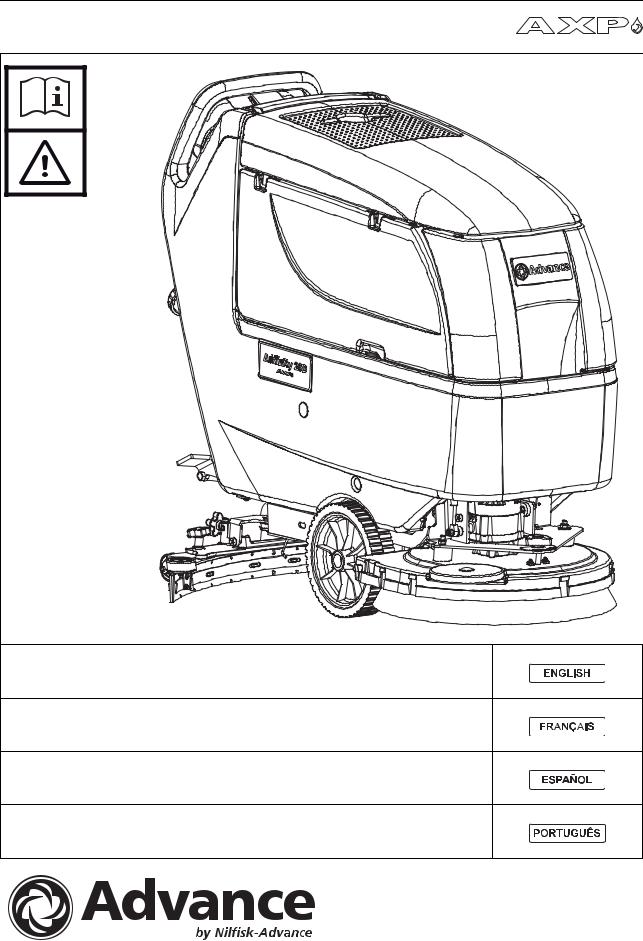
Adfinity™ 20D |
Adfinity™ X20D / X20C / X24D |
INSTRUCTIONS FOR USE |
Advance model: 908 7163 020 – 908 7164 020 – 908 7165 020 – 908 7166 020 |
INSTRUCTIONS D’UTILISATION |
Modèle Advance : 908 7163 020 – 908 7164 020 – 908 7165 020 – 908 7166 020 |
INSTRUCCIONES DE USO |
Modelo Advance: 908 7163 020 – 908 7164 020 – 908 7165 020 – 908 7166 020 |
INSTRUÇÕES DE USO |
Modelo Advance: 908 7163 020 – 908 7164 020 – 908 7165 020 – 908 7166 020 |
9096910000(1)2006-09 |

INSTRUCTIONS FOR USE |
|
INTRODUCTION ................................................................................................................................... |
2 |
MANUAL PURPOSE AND CONTENTS ........................................................................................................... |
2 |
TARGET ........................................................................................................................................................... |
2 |
HOW TO KEEP THIS MANUAL ....................................................................................................................... |
2 |
IDENTIFICATION DATA ................................................................................................................................... |
2 |
OTHER REFERENCE MANUALS .................................................................................................................... |
2 |
SPARE PARTS AND MAINTENANCE ............................................................................................................. |
2 |
CHANGES AND IMPROVEMENTS ................................................................................................................. |
2 |
OPERATION CAPABILITIES ............................................................................................................................ |
2 |
CONVENTIONS ................................................................................................................................................ |
2 |
UNPACKING/DELIVERY ...................................................................................................................... |
3 |
SAFETY ................................................................................................................................................. |
3 |
SYMBOLS ......................................................................................................................................................... |
3 |
GENERAL INSTRUCTIONS ............................................................................................................................. |
3 |
MACHINE DESCRIPTION ..................................................................................................................... |
5 |
MACHINE STRUCTURE .................................................................................................................................. |
5 |
CONTROL PANEL ............................................................................................................................................ |
7 |
BATTERY CHARGER DATA INSPECTION WINDOW .................................................................................... |
7 |
MACHINE STRUCTURE - DESCRIPTION ...................................................................................................... |
8 |
CONTROL AND SWITCH DESCRIPTION ....................................................................................................... |
9 |
WARNING LIGHT AND INDICATOR DESCRIPTION .................................................................................... |
10 |
BATTERY WARNING LIGHT DESCRIPTION ................................................................................................ |
10 |
ACCESSORIES/OPTIONS ............................................................................................................................. |
10 |
TECHNICAL DATA ......................................................................................................................................... |
11 |
WIRING DIAGRAM ......................................................................................................................................... |
12 |
USE ...................................................................................................................................................... |
13 |
BATTERY CHECK/SETTING ON A NEW MACHINE .................................................................................... |
13 |
BATTERY INSTALLATION AND BATTERY TYPE SETTING (WET OR GEL) .............................................. |
14 |
BEFORE MACHINE START-UP ..................................................................................................................... |
15 |
MACHINE START AND STOP ....................................................................................................................... |
18 |
MACHINE OPERATION (SCRUBBING/DRYING) ......................................................................................... |
18 |
TANK EMPTYING ........................................................................................................................................... |
20 |
AFTER USING THE MACHINE ...................................................................................................................... |
20 |
MACHINE LONG INACTIVITY ....................................................................................................................... |
20 |
FIRST PERIOD OF USE ................................................................................................................................ |
20 |
MAINTENANCE .................................................................................................................................. |
21 |
SCHEDULED MAINTENANCE TABLE .......................................................................................................... |
21 |
CHARGING THE BATTERIES ....................................................................................................................... |
21 |
MACHINE WORKING HOUR CHECK ............................................................................................................ |
22 |
SQUEEGEE CLEANING ................................................................................................................................ |
22 |
SQUEEGEE BLADE CHECK AND REPLACEMENT ..................................................................................... |
23 |
BRUSH/PAD CLEANING ................................................................................................................................ |
24 |
TANK AND VACUUM GRID WITH FLOAT CLEANING, AND COVER GASKET CHECK ............................ |
24 |
VACUUM SYSTEM MOTOR FILTER CLEANING ......................................................................................... |
25 |
SOLUTION FILTER CLEANING ..................................................................................................................... |
25 |
CLEAN WATER FILTER CLEANING ............................................................................................................. |
26 |
FUSE CHECK/REPLACEMENT ..................................................................................................................... |
27 |
BRUSH/PAD-HOLDER/CYLINDRICAL BRUSH DECK DISASSEMBLY/ASSEMBLY ................................... |
28 |
DETERGENT TANK CLEANING .................................................................................................................... |
29 |
AXP DRAINING .............................................................................................................................................. |
29 |
TROUBLESHOOTING ........................................................................................................................ |
30 |
SCRAPPING ........................................................................................................................................ |
30 |
9096910000(1)2006-09 |
1 |

INSTRUCTIONS FOR USE
INTRODUCTION
NOTE
The numbers in brackets refer to the components shown in Machine Description chapter.
MANUAL PURPOSE AND CONTENTS
The purpose of this Manual is to provide the operator with all necessary information to use the machine properly, in a safe and autonomous way. It contains information about technical data, safety, operation, storage, maintenance, spare parts and disposal.
Before carrying out any procedure on the machine, the operators and qualified technicians must read this Manual carefully. Contact Nilfisk-Advance in case of doubts regarding the interpretation of the instructions and for any further information.
TARGET
This Manual is intended for operators and technicians qualified to perform the machine maintenance.
The operators must not carry out procedures reserved for qualified technicians. Nilfisk-Advance will not be answerable for damages coming from the non-observance of this prohibition.
HOW TO KEEP THIS MANUAL
The Instructions for Use Manual must be kept near the machine, inside an adequate case, away from liquids and other substances that can cause damage to it.
IDENTIFICATION DATA
The machine model and serial number are marked on the plate (34).
The machine model year is shown after the Date Code on the serial plate (A06 means January 2006).
This information is useful when requiring machine spare parts. Use the following table to write down the machine identification data.
MACHINE model ..............................................................
MACHINE serial number ..................................................
OTHER REFERENCE MANUALS
–Electronic battery charger Manual to be considered as integral part of this Manual Moreover, the following Manuals are available:
–Service Manual (that can be consulted at Nilfisk-Advance Service Centers)
–Spare Parts List (supplied with the machine)
SPARE PARTS AND MAINTENANCE
All necessary operating, maintenance and repair procedures must be carried out by qualified personnel or by Nilfisk-Advance Service Centers. Only original spare parts and accessories must be used.
Contact Nilfisk-Advance for service or to order spare parts and accessories, specifying the machine model and serial number.
CHANGES AND IMPROVEMENTS
Nilfisk-Advance constantly improves its products and reserves the right to make changes and improvements at its discretion without being obliged to apply such benefits to the machines that were previously sold.
Any change and/or addition of accessories must be approved and performed by Nilfisk-Advance.
OPERATION CAPABILITIES
These scrubber-dryers are used to clean (scrubbing and drying) smooth and solid floors, in civil or industrial environment, under safe operation conditions by a qualified operator.
The scrubber-dryer cannot be used for moquette and carpet cleaning.
CONVENTIONS
Forward and backward, front and rear, left and right references are intended with the operator in driving position with the hands on the handlebar (2).
2 |
9096910000(1)2006-09 |
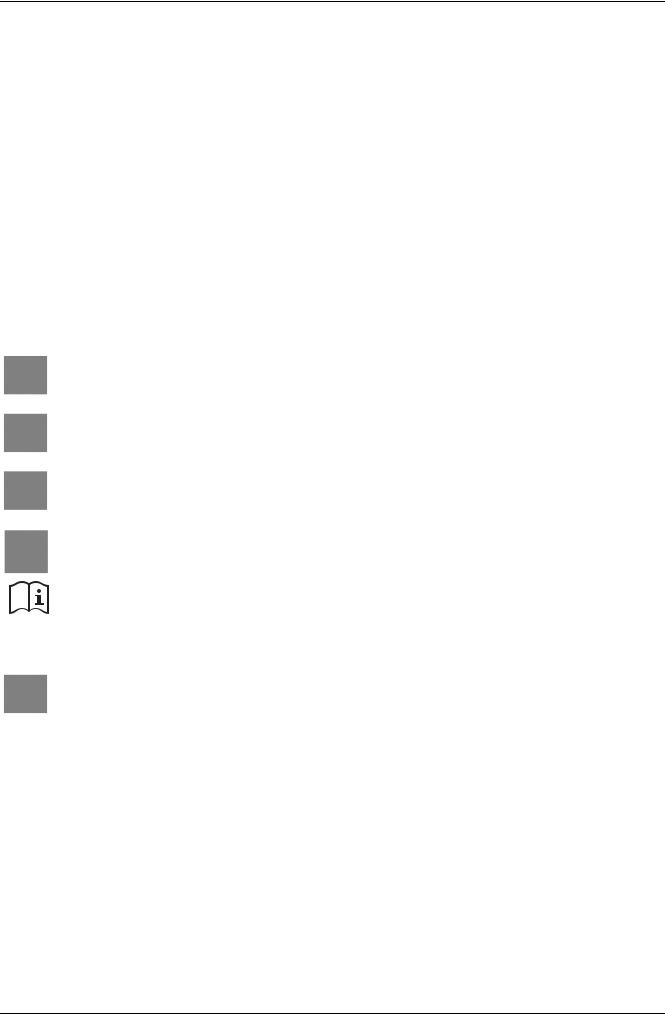
INSTRUCTIONS FOR USE 
UNPACKING/DELIVERY
To unpack the machine, carefully follow the instructions on the packing.
When the machine is delivered, check that the packing and the machine were not damaged during transportation. In case of visible damages, keep the packing and have it checked by the carrier that delivered it. Call the carrier immediately to fill in a damage claim.
Check that the machine is equipped with the following features:
1.Technical documents:
–Scrubber-dryer Instructions for Use Manual
–Electronic battery charger Manual
–Scrubber-dryer Spare Parts List
2.No. 2 lamellar fuses
SAFETY
The following symbols indicate potentially dangerous situations. Always read this information carefully and take all necessary precautions to safeguard people and property.
The operator's cooperation is essential in order to prevent injury. No accident prevention program is effective without the total cooperation of the person responsible for the machine operation. Most of the accidents that may occur in a factory, while working or moving around, are caused by failure to comply with the simplest rules for exercising prudence. A careful and prudent operator is the best guarantee against accidents and is essential for successful completion of any prevention program.
SYMBOLS
DANGER!
It indicates a dangerous situation with risk of death for the operator.
WARNING!
It indicates a potential risk of injury for people or damage to objects.
CAUTION!
It indicates a caution related to important or useful functions.
Pay careful attention to the paragraphs marked by this symbol.
NOTE
It indicates a remark related to important or useful functions.
CONSULTATION
It indicates the necessity to refer to the Instructions for Use Manual before performing any operation.
GENERAL INSTRUCTIONS
Specific warnings and cautions to inform about potential damages to people and machine are shown below.
DANGER!
–Disconnect the batteries before performing any maintenance/repair procedure.
–This machine must be used by properly trained and authorized personnel only. Children or disabled people cannot use this machine.
–Keep the battery far from sparks, flames and incandescent material. During the normal operation explosive gases are released.
–Do not wear jewelry when working near electrical components.
–Do not work under the lifted machine without supporting it with safety stands.
–Do not operate the machine near toxic, dangerous, flammable and/or explosive powders, liquids or vapors.
–Battery charging produces highly explosive hydrogen gas. Keep the tanks open during battery charging and perform this procedure in well-ventilated areas and away from bare flames.
9096910000(1)2006-09 |
3 |

INSTRUCTIONS FOR USE
WARNING!
–Before using the battery charger, ensure that frequency and voltage values, indicated on the machine serial number plate, match the electrical mains voltage.
–Do not pull or carry the machine by the battery charger cable and never use the battery charger cable as a handle. Do not close a door on the battery charger cable, or pull the battery charger cable around sharp edges or corners. Do not run the machine on the battery charger cable. Keep the battery charger cable away from heated surfaces.
–Do not charge the batteries if the battery charger cable or the plug are damaged. If the machine is not working as it should, has been damaged, left outdoors or dropped into water, return it to the Service Center.
–To reduce the risk of fire, electric shock, or injury, do not leave the machine unattended when it is plugged in. Before performing any maintenance procedure, disconnect the battery charger cable from the electrical mains.
–Do not smoke while charging the batteries.
–Always protect the machine against the sun, rain and bad weather, both under operation and inactivity condition. Store the machine indoors.
–Do not allow to be used as a toy. Close attention is necessary when used near children.
–Use only as described in this Manual. Only Nilfisk-Advance recommended accessories must be used.
–Take all necessary precautions to prevent hair, jewelry and loose clothes from being caught by the machine moving parts.
–Do not leave the machine unattended without being sure that it cannot move independently.
–Do not use the machine on slopes with a gradient exceeding the specifications.
–Do not use the machine in particularly dusty areas.
–While using this machine, take care not to cause damage to people or objects.
–Do not bump into shelves or scaffoldings, especially where there is a risk of falling objects.
–Do not put any can containing fluids on the machine.
–The machine operating temperature must be between +32°F and +104°F (0°C and +40°C).
–The machine storage temperature must be between +32°F and +104°F (0°C and +40°C).
–The humidity must be between 30% and 95%.
–Do not use the machine as a means of transport.
–Do not use the machine on slopes with an inclination higher than 2%.
–Do not allow the brushes to operate while the machine is stationary to avoid damaging the floor.
–In case of fire, use a powder fire extinguisher, not a water one.
–Do not tamper with the machine safety guards and follow the ordinary maintenance instructions scrupulously.
–Do not allow any object to enter into the openings. Do not use the machine if the openings are clogged. Always keep the openings free from dust, hairs and any other foreign material which could reduce the air flow.
–Do not remove or modify the plates affixed to the machine.
–If the machine is used according to the instructions, the vibrations are not dangerous. The machine vibration level is less than 98.4 in/s2 (2.5 m/s2) (98/37/EEC-EN 1033/1995).
–This machine cannot be used on roads or public streets.
–Pay attention during machine transportation when temperature is below freezing point. The water in the recovery tank or in the hoses could freeze and seriously damage the machine.
–Use the brushes and pads supplied with the machine and those specified in the Instructions for Use Manual. Using other brushes or pads could reduce safety.
–In case of machine malfunctions, ensure that these are not due to lack of maintenance. Otherwise, request assistance from the authorized personnel or from an authorized Service Center.
–If parts must be replaced, require ORIGINAL spare parts from a Dealer or Authorized Retailer.
–To ensure the proper and safe operation of the machine, have the scheduled maintenance, detailed in the relevant chapter of this Manual, performed by the authorized personnel or an authorized Service Center.
–Carefully read all the instructions before carrying out any maintenance/repair procedure.
–Do not wash the machine with direct or pressurized water jets, or with corrosive substances.
–The machine must be disposed of properly, because of the presence of toxic-harmful materials (batteries, etc.), which are subject to standards that require disposal in special centers (see Scrapping chapter).
4 |
9096910000(1)2006-09 |

INSTRUCTIONS FOR USE 
MACHINE DESCRIPTION
MACHINE STRUCTURE
1.Control panel
2.Handlebar
3.Drive paddle
4.Speed adjuster
5.Battery charger data inspection window
6.Battery charger cable
7.Battery charger cable holder
8.Solution/clean water rear filler neck
9.Water removable filler hose (optional)
10.Squeegee lifting/lowering lever
11.Deck lifting/lowering pedal
11a. Deck lifting
11b. Deck lowering
11c. Extra pressure activation (optional)
12.Battery connector (red) This connector also works as EMERGENCY switch, to stop immediately all functions.
13.Rear steering wheel
14.Front wheels on fixed axle
15.Squeegee vacuum hose
16.Recovery water drain hose
17.Solution/clean water drain and level check hose
18a. Deck with one brush/pad-holder
18b. Deck with two brushes/pad-holders
18c. Deck with two cylindrical brushes
19a. Brush/pad-holder
19b. Cylindrical brushes
20.Solution/clean water tank
21.Recovery water tank
22.Recovery water tank cover
23.Can holder
24.Pocket (optional)
25.Squeegee
26.Squeegee mounting handwheels
27.Squeegee balance adjusting handwheel
28.Machine straight forward movement adjusting handwheel
29.Battery connection diagram
30a. Recovery water tank cover (opened to be cleaned)
30b. Recovery water tank cover (completely opened)
31.Tank cover gasket
32.Cover movable retaining plate
33.Cover fixed retaining plate
34.Serial number plate/technical data
35.Plug for squeegee vacuum hose cleaning
36.Vacuum grid with automatic shut-off float
37.Solution front filler neck
38.Foam filter
39.Compensation hole
40.Recovery water tank (open)
41.Tank lifting handle
42.Tank safety cable
43.Vacuum system motor cover
44.Vacuum system motor sound-deadening filter
45.Detergent tank (*)
46.Detergent tank filling cap (*)
47.Detergent tank handle (*)
48.Detergent supply hose to brushes (*)
49.Detergent pump (*)
50.Water pump (*)
51.Clean water filter (*)
52.Batteries
53.Battery caps
54.Solution filter (*)
55.Solution/clean water tap
56.Solenoid valve
57.Reference table for detergent proportioning (*)
(*)Only for X20D, X20C, X24D.
9096910000(1)2006-09 |
5 |

INSTRUCTIONS FOR USE
32
31
37
38
18c
19b
24 |
23 |
1 |
2 |
|
22 |
|
|
3 |
9 |
|
|
|
4 |
|
|
|
|
|
21 |
5 |
|
6 |
||
|
20 |
|
|
7 |
|
17 |
|
8 |
|
|
|
10 |
11c |
||
56 |
|
|||
16 |
|
|
11b |
|
18a |
|
|
|
|
|
|
|
11a |
|
19a |
|
|
|
|
|
|
|
|
28 |
|
|
14 |
|
|
11 |
|
|
|
|
26 |
||
|
|
|
54 55 13 |
26 15 |
25 12 27 |
|
|
30b |
|
42 |
40 |
41 |
|
33 |
|
|
|
|
|
|
39 |
|
|
|
|
44 |
|
|
30a |
|
|
|
||
|
|
|
|
|
||
|
|
|
|
|
|
|
|
|
34 |
43 |
|
|
|
|
|
|
|
|
|
|
|
|
35 |
29 |
|
|
|
|
|
|
|
|
48 |
|
|
|
|
52 |
|
|
|
|
|
|
|
|
45 |
|
|
|
36 |
53 |
46 |
|
|
|
|
|
47 |
18b |
||
|
|
|
|
19a
|
47 |
|
51 |
48 |
|
45 |
||
|
50
46
49 |
57 |
S311310
6 |
9096910000(1)2006-09 |
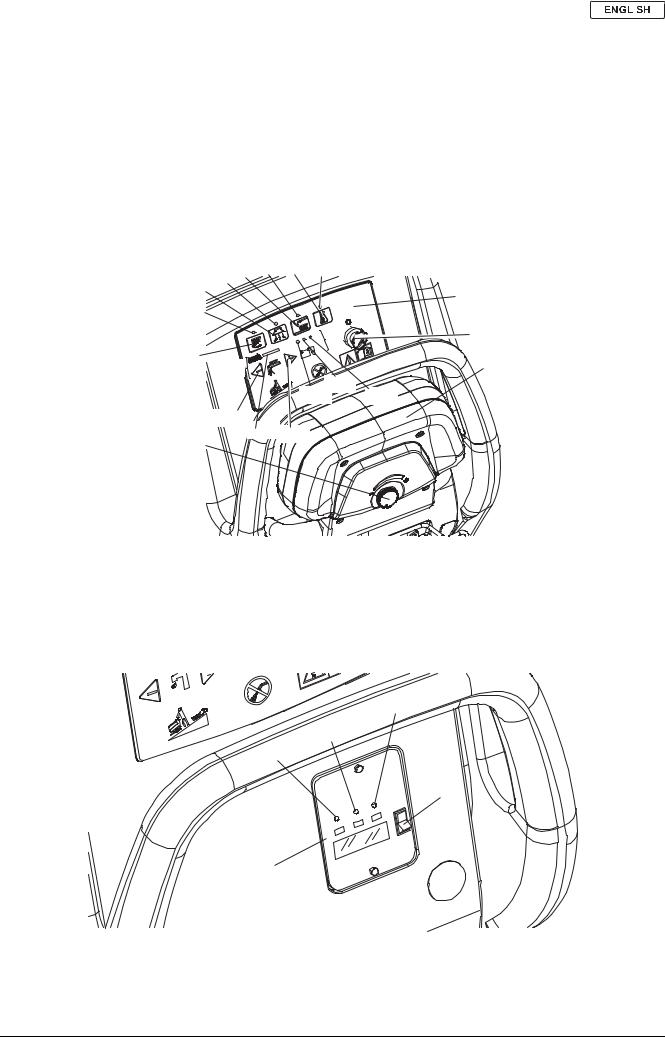
|
|
|
INSTRUCTIONS FOR USE |
|
|
|
|
|
|
|
|
|
|
|
CONTROL PANEL |
|
|
|
|
71. |
Brush/pad-holder and vacuum system switch |
81a. |
Charged battery warning light (green) |
|
72. |
Brush/pad-holder and vacuum system switch warning |
81b. |
Semi-discharged battery warning light (yellow) |
|
|
light |
81c. |
Discharged battery warning light (red) |
|
73. |
Vacuum system switch |
82. |
Washing water flow control switches |
|
74. |
Vacuum system switch warning light |
82a. |
Flow increase switch |
|
75. |
Brush/pad-holder release switch |
82b. |
Flow decrease switch |
|
76. |
Brush/pad-holder release switch warning light |
82c. |
Washing water flow indicator |
|
77. |
Detergent flow control switch (*) |
83. |
Forward/reverse gear drive paddle |
|
78. |
Detergent flow control switch warning light (*) |
84. |
Forward/reverse speed adjuster |
|
79.Hour counter (optional)
80. Ignition key (0 - I) |
(*) Only for machines with AXP |
81.Battery charge indicator
73 74 |
75 76 |
77 |
78 |
|
||
|
|
|
|
79 |
||
72 |
|
|
|
|
|
|
|
|
|
|
|
|
|
71 |
|
|
|
|
81 |
80 |
|
82 |
|
|
|
83 |
|
|
|
|
|
81c81b |
||
|
82b |
|
|
81a |
||
84 |
82c |
82a |
|
|||
|
|
|
|
|
|
|
S311312
BATTERY CHARGER DATA INSPECTION WINDOW
90.Electronic battery charger
91.Lead (WET) or gel (GEL) battery selector
92.Green warning light (the battery charger is on and batteries are charged)
93.Yellow warning light (the battery charger is on and batteries are semi-discharged)
94.Red warning light (the battery charger is on and it is charging the batteries)
92
93
94
91
90
S311313
9096910000(1)2006-09 |
7 |

INSTRUCTIONS FOR USE
MACHINE STRUCTURE - DESCRIPTION
Control panel (1) - It is the area where machine controls are located, see Control and Switch Description paragraph. Handlebar (2) - Grasp it and use it to maneuver the machine.
Drive paddle (3) - See Control and Switch Description paragraph. Speed adjuster (4) - See Control and Switch Description paragraph.
Battery charger data inspection window (5) - See Battery Warning Light Description paragraph. Battery charger cable (6) - Connect it to the electrical mains to charge the batteries.
Battery charger cable holder (7) - Use it to roll up the battery charger cable when it is not in use. Fasten the cable safely. Solution rear filler neck (8) - Open it to pour the solution/clean water (**) in the tank. Use only low-foam detergents. Water removable filler hose (optional) (9) - For easily filling the tank with water (**).
Squeegee lifting/lowering lever (10) - To lift or lower the squeegee. Deck lifting/lowering pedal (11) - It has the following functions: (11a) Deck lifting
(11b) Deck lowering
(11c) Extra pressure activation for 20D e X20D (optional for X24D).
This function cannot be used for 20D, X20D and X24D when equipped with cylindrical brush deck.
Battery connector (red) (12) - It connects the batteries to the machine electrical system. It must be connected to the external battery charger, when the machine is not equipped with on-board battery charger. This connector also works as EMERGENCY switch, to stop immediately all functions. If necessary, grasp the handle and disconnect the connector by pulling it strongly.
Rear steering wheel (13) - It allows the machine to steer.
Front wheels on fixed axle (14) - They bear the machine weight. Driving wheels (*).
Squeegee vacuum hose (15) - It conveys the recovery water from the squeegee to the recovery water tank. To easily clean it, remove the plug (35).
Recovery water drain hose (16) - It drains the recovery water from the tank.
Solution/clean water drain and level check hose (**) (17) - It is equipped with level marks to check the solution/water level in the tank. Disconnect the upper end to drain the tank.
Brush/pad-holder deck (18a, 18b, 18c) - On the deck, brushes or pad-holders and the relevant motors are installed. Decks are easy to remove (with tools) and can be replaced with other types of deck. Three types of deck are available: with one brush/pad-holder, with two brushes/pad-holders, with two cylindrical brushes (for instructions, see the relevant paragraphs). Brushes/pads (19a, 19b) - According to the type of deck, the machine can be equipped with: brushes, pad-holders or cylindrical brushes.
Solution/clean water tank (20) - It contains the solution/clean water (**).
Recovery water tank (21) - It contains the recovery water collected by the squeegee and vacuumed. Recovery water tank cover (22) - It hermetically closes the recovery water tank.
Can holder (23) - Compartment to store a can or small objects. Pocket (optional) (24) - Elastic retainer for documents.
Squeegee (25) - It collects the solution after scrubbing. Choose the squeegee according to the type of deck (see the relevant paragraph).
Squeegee mounting handwheels (26) - They fasten the squeegee to the machine.
Squeegee balance adjusting handwheel (27) - To adjust the squeegee blade position.
Machine straight forward movement adjusting handwheel (***) (28) - Turn it clockwise or counter-clockwise for machine straight forward movement.
Battery connection diagram (29) - It shows how to connect the batteries.
Recovery water tank cover (opened) - By turning the retaining plate (32), it can be removed. It can be opened in one of the following positions:
(30a) Opened to be cleaned.
(30b) Completely opened.
Tank cover gasket (31) - The gasket must be integral for an efficient vacuuming of the recovery water. Cover retaining plates (32) and (33) - Turn the retaining plate (32) to remove the tank cover.
Serial number plate/technical data/conformity certification (34) - It contains the machine data. Plug for squeegee vacuum hose cleaning (35) - Remove it to clean the vacuum hose.
Vacuum grid with automatic shut-off float (36) - Keep it clean, to avoid a stuck in the vacuum system.
8 |
9096910000(1)2006-09 |

INSTRUCTIONS FOR USE 
Solution front filler neck (37) - For easily filling the tank with solution.
Foam filter (38) - It prevents debris or foreign materials from entering into the tank. Compensation hole (39) - Keep it clean, for an efficient vacuuming of the recovery water. Recovery water tank (open) (40) - Empty and lift it to reach the batteries and the detergent tank. Tank lifting handle (41) - Grasp it to lift the tank, only when it is empty.
Tank safety cable (42) - It keeps the tank opened.
Vacuum system motor cover (43) - It retains the sound-deadening filter and protects the vacuum system motor.
Vacuum system motor sound-deadening filter (44) - It protects the motor from debris and foreign material, and it deadens the vacuum system motor noise.
Detergent tank (*) (45) - It contains the detergent that will be mixed with the clean water.
Detergent tank filler plug (*) (46) - Open it to pour the detergent in the tank. Use only low-foam detergents.
Detergent tank handle (*) (47) - Use it to lift/lower the tank.
Detergent supply hose to brushes (*) (48) - It supplies the detergent to the brushes.
Detergent pump (*) (49) - It vacuums the detergent from the tank and supplies it, together with the clean water, to the brushes. Water pump (*) (50) - It vacuums the water from the tank and supplies it to the brushes.
Clean water filter (*) (51) - It filters clean water before supplying it to the pump and to the brushes.
Batteries (52) - They supply current for machine operation. The machine can be equipped with lead (WET) or gel (GEL) batteries.
Battery caps (53) - WET batteries are equipped with caps for maintenance purposes.
Solution filter (54) - It filters the solution before supplying it to the solenoid valve and to the brushes. Solution/clean water tap (55) - It closes the solution/clean water flow.
Solenoid valve (56) - It controls the water flow. If the machine is equipped with AXP it works as a tap.
Reference table for detergent proportioning (*) (57) - It indicates the percentages of detergent in the washing water. The same percentages are shown by the flow indicator (82c).
(*)Only for X20D, X20C, X24D.
(**) If the machine is equipped with AXP [switch (77) (optional) enabled] pour clean water in the tank, otherwise pour solution. (***) Only for deck with one brush/pad-holder.
CONTROL AND SWITCH DESCRIPTION
Brush/pad-holder and vacuum system switch (71) - It turns on the brushes/pad-holders and the vacuum system. When pressed twice, it turns off the brushes/pad-holders. To turn off the vacuum system, press the switch (73).
Vacuum system switch (73) - It turns the vacuum system on and off.
Brush/pad-holder release switch (75) - It releases the brushes/pad-holders, and it can be pressed only when the brushes/pad-holders are off.
Detergent flow control switch (*) (77) - It turns the AXP on and off and it allows to change the detergent concentration. Ignition key (80) - It turns the control panel on and off.
Washing water flow control switches (82) - To control the detergent quantity supplied to the brushes. Flow increase switch (82a) - It increases the water quantity supplied to the brushes.
Flow decrease switch (82b) - It decreases the water quantity supplied to the brushes. Washing water flow indicator (82c) - It shows the water quantity supplied to the brushes.
Drive paddle (83) - Push it forward to move the machine forward, push it backwards to move the machine in reverse. The brushes/pad-holders and the water flow turn on only when the paddle is pushed in either directions. When the paddle is released, the brushes/pad-holders turn off.
Forward/reverse gear speed adjuster (84) - It adjusts the machine maximum speed, when the drive paddle is pushed to the end of stroke.
(*)Only for machines with AXP
9096910000(1)2006-09 |
9 |

INSTRUCTIONS FOR USE
WARNING LIGHT AND INDICATOR DESCRIPTION
Brush/pad-holder and vacuum system switch warning light (72) - When the warning light turns on, it means that the relevant function is activated.
Vacuum system switch warning light (74) - When the warning light turns on, it means that the relevant function is activated. Brush/pad-holder release switch warning light (76) - When the warning light turns on, it means that the relevant function is activated.
Detergent flow control switch warning light (78) (*) - When the warning light turns on, it means that the relevant function is activated.
Hour counter (optional) (79) - It shows the machine working hours.
(*)Only for machines with AXP
BATTERY WARNING LIGHT DESCRIPTION
Battery charge indicator (81) - It shows battery autonomy.
Green warning light (81a) - When it is on, the battery are charged (residual autonomy depends on battery capacity and working conditions.).
Yellow warning light (81b) - When it is on, the battery are semi-discharged (residual autonomy is 10 minutes approximately). Red warning light (81c) - When it is on, the battery are discharged (the autonomy is over, the batteries must be recharged (see the procedure in the relevant paragraph)).
ACCESSORIES/OPTIONS
In addition to the standard components, the machine can be equipped with the following accessories/options, according to the machine specific use:
1.GEL batteries
2.Brushes and cylindrical brushes of different materials
3.Pads of different materials
4.Polyurethane squeegee blades
5.Front and rear wheels of different materials
6.Hour counter
7.Solution/clean water removable filler hose
8.Pocket
For further information concerning the above-mentioned optional accessories, contact an authorized Retailer.
10 |
9096910000(1)2006-09 |

|
|
|
INSTRUCTIONS FOR USE |
|
|
||
|
|
|
|
||||
|
|
|
|
||||
|
|
|
|
|
|
|
|
TECHNICAL DATA |
|
|
|
|
|
|
|
|
|
General technical data |
|
|
|
|
|
|
|
|
|
|
|
||
|
|
20D |
X20D |
X20C |
X24D |
||
Model |
|
(1 brush/pad-holder, |
(1 brush/pad-holder, |
(2 cylindrical brushes, |
(2 brushes/pad-hold- |
||
|
|
with drive system) |
with drive system) |
with drive system) |
ers, with drive system) |
||
|
|
|
|
|
|
|
|
Machine height |
|
|
42.9 in (1,088 mm) |
|
|
|
|
|
|
|
|
|
|
|
|
Solution/clean water tank capacity |
|
|
15.3 US gal (58 liters) |
|
|
|
|
|
|
|
|
|
|
|
|
Recovery water tank capacity |
|
|
15.8 US gal (60 liters) |
|
|
|
|
|
|
|
|
|
|
|
|
Front wheel diameter |
|
|
9.8 in (250 mm) |
|
|
|
|
|
|
|
|
|
|
|
|
Front wheel specific pressure on the ground |
|
|
174 lbf/in2 (1.2 N/mm2) |
|
|
|
|
Rear wheel diameter |
|
|
3.9 in (100 mm) |
|
|
|
|
|
|
|
|
|
|
|
|
Vacuum system motor power |
|
|
0.4 hp (330 W) |
|
|
|
|
|
|
|
|
|
|
|
|
Drive system motor power |
|
|
0.26 hp (200 W) |
|
|
|
|
|
|
|
|
|
|
|
|
Drive speed (variable) |
|
|
0 to 3.5 mph (0 to 5.6 km/h) |
|
|
|
|
|
|
|
|
|
|
|
|
Gradeability |
|
|
2 % |
|
|
|
|
|
|
|
|
|
|
|
|
Sound pressure level (at the operator's |
|
|
65.8 dB(A) |
|
|
|
|
position) |
|
|
|
|
|
||
|
|
|
|
|
|
|
|
Standard batteries |
|
|
WET (2 x 12 V) 24 V 130 Ah |
|
|
|
|
|
|
|
|
|
|
|
|
Battery compartment size (width x length x |
|
|
13.8 x 13.8 x 11.8 in (350 x 350 x 300 mm) |
|
|
|
|
height) |
|
|
|
|
|
||
|
|
|
|
|
|
|
|
Vacuum system circuit capacity |
|
|
41.5 in H2O (1,055 mm H2O) |
|
|
|
|
Technical data for machines with brush/pad-holder deck |
|
|
|
||||
|
|
|
|
|
|
||
|
|
|
20D |
X20D |
X24D |
||
Model |
|
(1 brush/pad-holder, |
(1 brush/pad-holder, |
(2 brushes/pad-hold- |
|||
|
|
|
with drive system) |
with drive system) |
ers, with drive system) |
||
|
|
|
|
|
|||
Cleaning width |
|
20.9 in (530 mm) |
24 in (610 mm) |
||||
|
|
|
|
||||
Squeegee width |
|
29.9 in (760 mm) |
31.9 in (810 mm) |
||||
|
|
|
|
||||
Machine maximum length |
|
52.1 in (1,323 mm) |
51.6 in (1,311 mm) |
||||
|
|
|
|
||||
Machine width without squeegee |
|
21.3 in (541 mm) |
25.4 in (646 mm) |
||||
|
|
|
|
||||
Brush diameter |
|
20.9 in (530 mm) |
12.0 in (305 mm) |
||||
|
|
|
|
|
|||
Weight without batteries and with empty tanks |
|
229.3 lb (104 kg) |
231.5 lb (105 kg) |
||||
|
|
|
|
||||
Maximum weight with batteries and full tanks |
|
555.6 lb (252 kg) |
557.8 lb (253 kg) |
||||
|
|
|
|
|
|||
Brush motor power |
|
0.6 hp (480 W) |
0.46 hp (350 W) |
||||
|
|
|
|
||||
Brush speed |
|
153 rpm |
230 rpm |
||||
|
|
|
|
|
|
||
Brush/pad-holder pressure with extra-pressure deactivated |
|
45.2 lb (20.5 kg) |
|
|
|
||
|
|
|
|
|
|
||
Brush/pad-holder pressure with extra-pressure activated |
|
61.3 lb (27.8 kg) |
|
|
|
||
|
|
|
|
|
|||
Technical data for machines with cylindrical brush deck |
|
|
|
||||
|
|
|
|
|
|
|
|
Model |
|
|
X20C |
|
|
|
|
|
(2 cylindrical brushes, with drive system) |
||||||
|
|
|
|||||
|
|
|
|
|
|
|
|
Cleaning width |
|
|
20.1 in (510 mm) |
|
|
|
|
|
|
|
|
|
|
|
|
Squeegee width |
|
|
29.9 in (760 mm) |
|
|
|
|
|
|
|
|
|
|
|
|
Machine maximum length |
|
|
49.3 in (1,253 mm) |
|
|
|
|
|
|
|
|
|
|
|
|
Machine width without squeegee |
|
|
22.6 in (575.5 mm) |
|
|
|
|
|
|
|
|||||
Cylindrical brush size (diameter x length) |
|
4.3 x 19.1 in (110 x 485 mm) |
|||||
|
|
|
|
|
|
|
|
Weight without batteries and with empty tanks |
|
|
253.5 lb (115 kg) |
|
|
|
|
|
|
|
|
|
|
|
|
Maximum weight with batteries and full tanks |
|
|
579.1 lb (263 kg) |
|
|
|
|
|
|
|
|
|
|
|
|
Brush motor power |
|
|
0.54 hp (400 W) |
|
|
|
|
|
|
|
|
|
|
|
|
Cylindrical brush rotation speed |
|
|
570 rpm |
|
|
|
|
|
|
|
|
|
|
|
|
Cylindrical brush pressure |
|
|
58.4 lb (26.5 kg) |
|
|
|
|
|
|
|
|
|
|
|
|
9096910000(1)2006-09 |
11 |
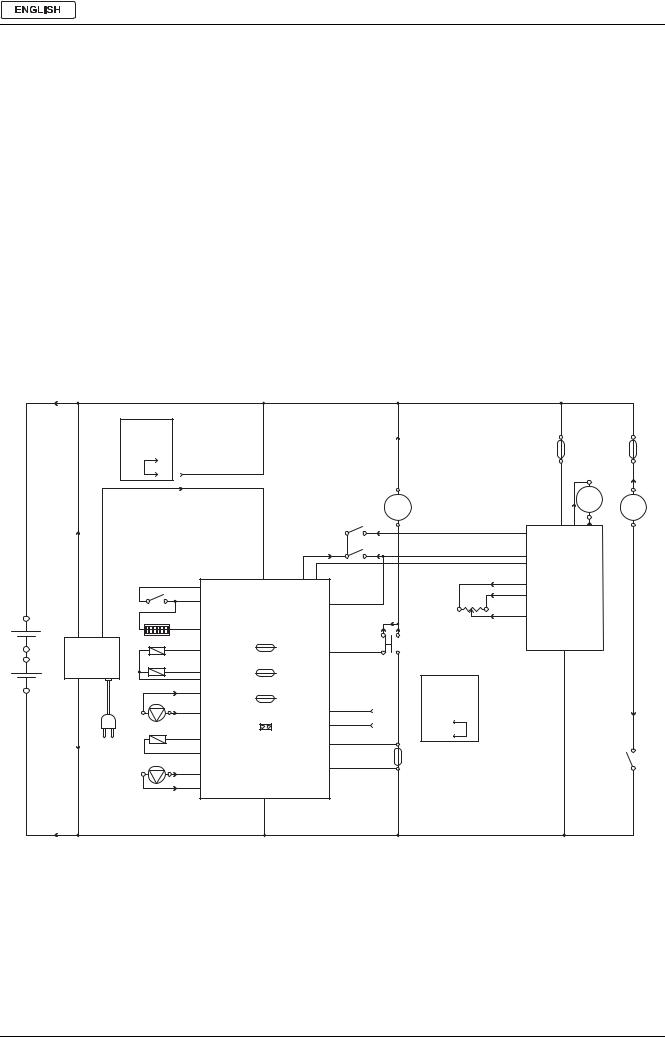
INSTRUCTIONS FOR USE
WIRING DIAGRAM
BAT: 24 V battery
C1: Battery connector
C2: Battery charger connector CH: Battery charger
CSC: Cylindrical brush deck secondary connector
EB1: Function electronic board |
|
|
|
|
|||
EB2: Drive system electronic board |
|
|
|||||
ES1: Brush electromagnetic switches |
|
|
|||||
ES2: Vacuum system relay |
|
|
|
|
|
||
EV1: Solenoid valve |
|
|
|
|
|
||
F1: |
Deck fuse |
|
|
|
|
|
|
F2: |
Vacuum system fuse |
|
|
|
|
|
|
F3: |
Drive system fuse |
|
|
|
|
|
|
F4: |
Signal circuit fuse |
|
|
|
|
|
|
F5: Brush/pad-holder release fuse |
|
|
|||||
F6: |
Pump fuse |
|
|
|
|
|
|
HM: |
Hour counter (optional) |
|
|
|
|
||
K1: |
Ignition key |
|
|
|
|
|
|
M1: |
Brush/pad-holder motor |
|
|
|
|
||
M2: |
Vacuum system motor |
|
|
|
|
|
|
M3: |
Drive system motor |
|
|
|
|
|
|
|
|
C1 |
|
|
|
|
|
|
RD |
RD |
|
|
|
|
RD |
|
|
|
C2.3 |
|
|
|
|
|
|
|
C2.4 |
C2.3 |
|
|
|
|
|
|
|
|
|
||
|
|
|
|
|
C2.4 |
|
|
|
|
C2.1 |
|
|
|
|
RD |
|
|
|
|
|
|
|
|
|
|
|
|
|
RD |
J1.2 |
J1.1 |
|
|
|
K1 |
|
OG |
J1.6 |
EB1 |
|
|
|
|
|
|||
|
|
OG |
|
|
|
||
|
|
HM |
|
2 BN-BK |
|
|
|
+ |
|
1 |
|
J1.4 |
|
||
|
|
|
F4 |
||||
- |
BAT |
|
ES1 |
|
BU |
J1.11 |
|
|
|
|
|
|
|||
|
CH |
|
|
|
|
||
|
ES2 |
|
|
|
F5 |
||
+ |
|
|
BN |
|
|||
|
85 |
86 |
J1.12 |
||||
|
|
|
|
|
|||
- |
|
YE |
|
J1.13 |
|
||
|
|
|
|
F6 |
|||
|
|
|
BN |
J3.1 |
|||
|
|
|
M4 |
|
|||
|
|
|
|
BU |
|
|
|
|
|
|
|
|
J3.2 |
|
|
|
|
|
|
|
|
J4 |
|
|
|
|
|
|
|
|
|
|
|
|
EV1 |
|
BN |
J2.1 |
|
|
|
|
|
|
|
||
|
|
C2.2 |
|
|
|
|
|
|
|
|
|
BU |
J2.2 |
|
|
|
|
|
M5 |
|
|
||
|
|
|
|
|
|
||
|
|
|
|
WH |
|
|
|
|
|
|
|
|
J3.3 |
|
|
|
|
|
|
|
BU |
|
|
|
|
|
|
|
J3.4 |
|
|
|
|
|
|
|
|
J1.8 |
|
|
|
|
|
|
|
|
|
|
BK |
BK |
|
|
|
|
BK |
|
|
C1 |
|
|
|
|
|
M4: Water pump (**)
M5: Detergent pump (**)
RV2: Maximum speed potentiometer
SW1: Brush/drive system enabling microswitch
SW2: Reverse gear microswitch
(*)Only for machines with cylindrical brush deck
(**)Only for machines with AXP
Color code
BK: Black
BU: Blue
BN: Brown
GN: Green
GY: Grey
OG: Orange
PK: Pink
RD: Red
VT: Violet
WH: White
RD RD RD
|
|
|
|
|
F3 |
F2 |
|
|
|
|
|
RD |
BN |
|
|
M1 |
|
|
|
M3 |
|
|
|
|
|
M2 |
|
|
SW2 |
(3) |
YE-BK |
|
RD |
GY |
|
|
J1.2 |
+B M1 |
M2 |
||
|
SW1 |
|
|
|
|
|
VT |
(2) |
GN-BK |
|
|
|
|
(1) |
J1.12 |
|
|
|||
|
|
|
|
|
|
|
|
|
|
VT-BK |
J1.15 |
|
|
|
|
|
|
|
|
|
J1.3 J1.5 |
|
|
(6) |
RD |
|
|
|
|
|
(5) |
J1.1 |
|
|
|
|
|
BU |
EB2 |
|
|
J1.15 |
GN-BK |
BU |
RV2 |
J1.3 |
|
|
WH |
|
|
||||
|
|
BU |
|
|
|
|
|
|
(4) |
J1.4 |
|
|
|
|
|
|
|
|
|
|
J1.14 |
GY |
ES1 |
|
|
-B |
WH |
|
|
|
|
|
J3.6 |
BN |
CSC1 |
|
(*) |
|
|
|
|
|||
J3.5 |
RD-BK |
CSC2 |
BK |
CSC1 |
|
|
BU-BK |
|
|
CSC2 |
30 |
J1.9 |
|
|
|
||
|
OG-BK |
|
F1 |
|
ES2 |
J1.10 |
|
|
|
||
|
|
|
|
87 |
|
|
|
|
|
|
|
|
|
|
BK |
BK |
BK |
S311315
12 |
9096910000(1)2006-09 |
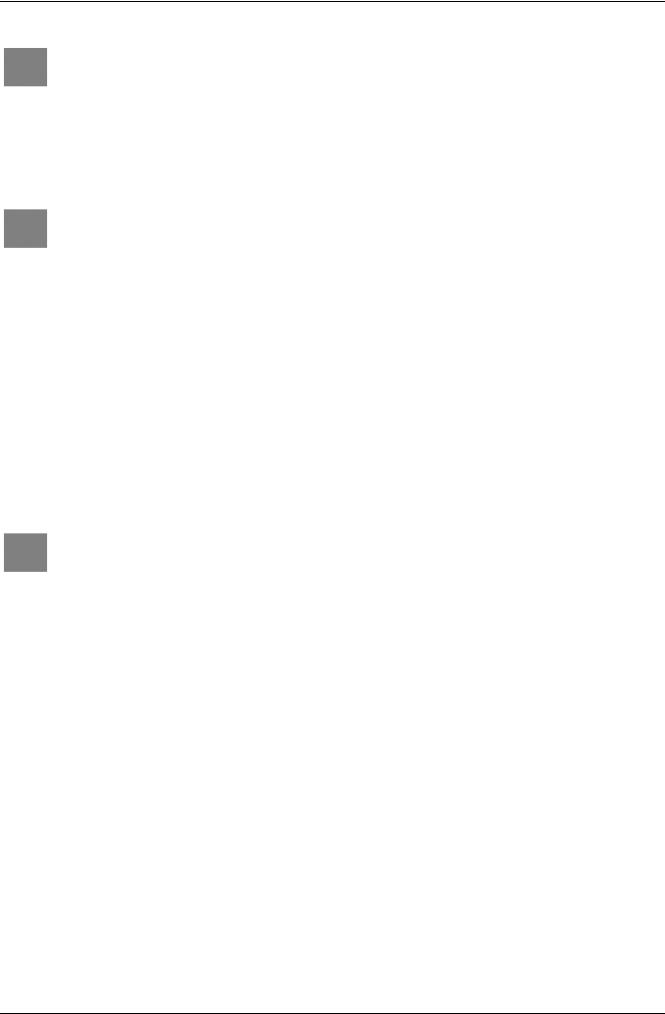
INSTRUCTIONS FOR USE 
USE
WARNING!
On some points of the machine there are some adhesive plates indicating:
–DANGER
–WARNING
–CAUTION
–CONSULTATION
While reading this Manual, the operator must pay particular attention to the symbols shown on the plates. Do not cover these plates for any reason and immediately replace them if damaged.
BATTERY CHECK/SETTING ON A NEW MACHINE
WARNING!
The electric components of the machine can be seriously damaged if the batteries are either improperly installed or connected. The batteries must be installed by qualified personnel only. Set the function electronic board and the built-in battery charger according to the type of batteries used (WET or GEL). Check the batteries for damage before installation.
Disconnect the battery connector and the battery charger plug. Handle the batteries with great care.
Install the battery terminal protection caps supplied with the machine.
The machine requires two 12 V batteries, connected according to the diagram (29).
The machine can be supplied in one of the following modes:
a) |
Batteries (WET or GEL) already installed and ready to be used |
1. |
Check that the batteries are connected to the machine with the connector (12). |
2. |
Insert the ignition key (80) and turn it to "I" position. |
|
If the green warning light (81a) turns on, the batteries are ready to be used. |
|
If the yellow or red warning light (81b) or (81c) turns on, the batteries must be charged (see the procedure in the |
|
Maintenance chapter). |
b) |
Batteries (WET) installed on the machine, but without electrolyte |
1.Open the cover (22) and check that the recovery water tank (21) is empty, otherwise empty it with the drain hose (16).
2.Grasp the handle (41) and carefully lift the tank (40).
3.Remove the caps (53) of the batteries (52).
WARNING!
Pay attention when using sulphuric acid, as it is corrosive. If it comes in contact with skin or eyes, rinse thoroughly with water and consult a physician.
Batteries have to be filled in a well-ventilated area. Wear protective gloves.
4.Fill up the battery elements with sulphuric acid for batteries [density from 2.79 to 2.84 lb at 77°F (1.27 to 1.29 kg at 25°C)] in accordance with the instructions specified in the Battery Manual. The correct quantity of sulphuric acid is shown in the Battery Manual.
5.To avoid damaging the floor, dry with a cloth both acid and water on the top of the batteries after charge.
6.Let the batteries rest and fill in with sulphuric acid in accordance with the instructions shown in the Battery Manual.
7.Charge the batteries (see the procedure in the Maintenance chapter).
c)Without batteries
1.Buy appropriate batteries (see the Technical Data paragraph).
For battery choice and installation, apply to qualified battery Retailers.
2.Set the machine and the battery charger (if equipped) according to the type of batteries (WET or GEL).
9096910000(1)2006-09 |
13 |
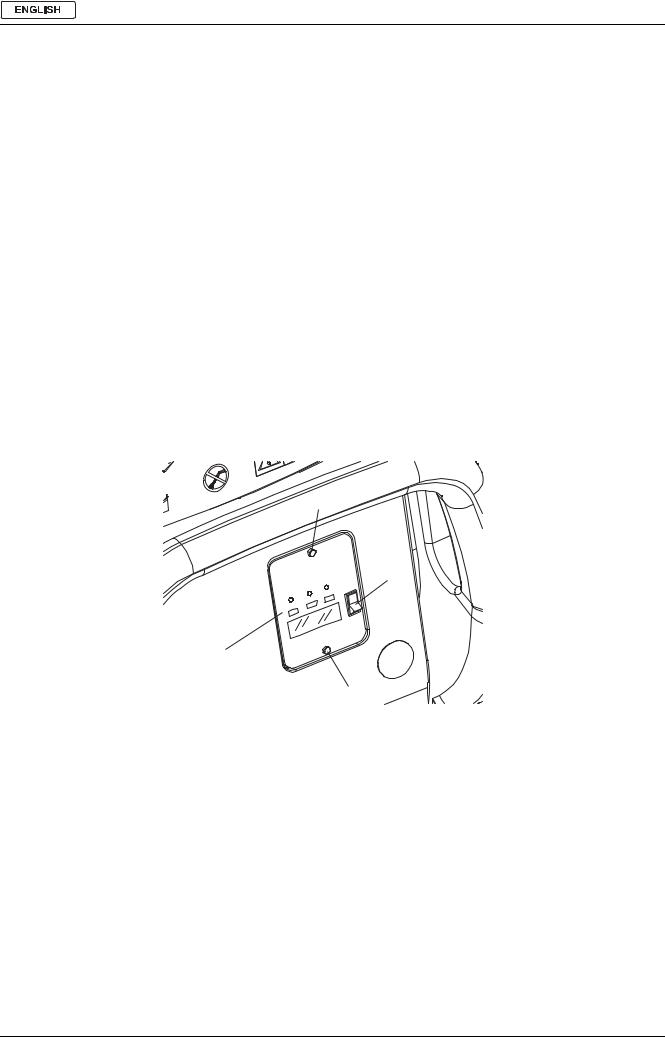
INSTRUCTIONS FOR USE
BATTERY INSTALLATION AND BATTERY TYPE SETTING (WET OR GEL)
According to the type of batteries (WET or GEL), set the electronic board of the machine and of the battery charger, according to the following procedure:
Machine setting
1.Turn the ignition key (80) to “I” and pay attention to the following in the very first seconds of machine operation:
–If the green warning light (81a) is flashing, the machine is set to GEL.
–If the red warning light (81c) is flashing, the machine is set to WET.
2.If the setting is to be changed, perform the following procedure.
3.Turn off the machine by turning the ignition key (80) to “0” position.
4.Press and hold the switches (71) and (73) at the same time, then turn the ignition key (80) to “I”.
5.Release the switches (71) and (73) at least 8 seconds after starting the machine.
6.Within 3 seconds, press the switch (73) again for a few seconds and check that the warning light for the required setting is flashing (as shown in step 1).
Battery charger setting
7.Remove the battery charger data inspection window screws (A, Fig. 1).
8.Remove the window (B).
9.Turn the battery charger selector (C) to WET position for lead batteries, or to GEL position for gel batteries.
10.Install the window (B) and tighten the screws (A).
Battery installation
11.Open the cover (22) and check that the recovery water tank (21) is empty, otherwise empty it with the drain hose (16).
12.Grasp the handle (41) and carefully lift the tank (40).
13.Install the batteries.
Battery charging
14.Charge the batteries (see the procedure in the Maintenance chapter).
A
C
B
A
S311316
Figure 1
14 |
9096910000(1)2006-09 |

INSTRUCTIONS FOR USE 
BEFORE MACHINE START-UP
Deck installation/removal
The machine can be equipped with either the brush/pad-holder deck (18a and 18b) or the cylindrical brush deck (18c). For deck installation/removal see the procedure in the Maintenance chapter.
NOTE
When the deck is installed/removed, it may be necessary to change the squeegee too, because they must have the same width. For correct matching of deck and squeegee, see the Squeegee Installation paragraph.
Brush/pad-holder installation/removal
1.According to the kind of cleaning to be carried out, the machine can be equipped either with brushes (A, Fig. 2) or pad-holders (B) with pads (C) together with the appropriate deck.
2.Turn the ignition key (80) to “0” position.
If equipped, turn the speed adjuster (84) to idle by turning it counter-clockwise.
3.Place the brushes (A) or the pad-holders (B) under the appropriate deck (18a) or (18b).
4.Lower the deck on the brushes/pad-holders by pressing the pedal (11).
5.Turn the ignition key (80) to “I” position.
6.Press the brush/pad-holder and vacuum system switch (71).
7.Slightly press the paddle (83) forward to engage the brushes/pad-holders, then release it. If necessary, repeat the procedure until the brushes/pad-holders are engaged.
S311317
Figure 2
WARNING!
Do not press the paddle (83) completely, otherwise the machine will start.
A light pressure on the paddle (83) is enough to engage the brushes/pad-holders and activate the brush/pad-holder motors.
8.To remove the brushes/pad-holders, the deck must be lifted by pressing the pedal (11), then press the switch (75) and wait for the brushes/pad-holders to fall on the floor.
Turn the ignition key (80) to “0” position.
Types of brushes available
12.0 in (305 mm) models |
20.9 in (530 mm) models |
||
08603842 |
- Prolene |
08837025 |
- Prolene |
|
|
|
|
08603872 |
- Midlite Grit 180 |
08837028 |
- Midlite Grit 180 |
|
|
|
|
08603873 |
- Midgrit 240 |
08837029 |
- Midgrit 240 |
|
|
|
|
08603874 |
- Prolite |
08837026 |
- Prolite |
|
|
|
|
08603875 |
- Union Mix |
08837027 |
- Union Mix |
|
|
|
|
9096910000(1)2006-09 |
15 |

INSTRUCTIONS FOR USE
Brush/pad application guide (suggestions only)
Models |
Midlite Grit 180 |
Midgrit 240 |
Prolene |
Prolite |
Union Mix |
General cleaning: |
|
|
|
|
|
|
|
|
|
|
|
Concrete |
|
|
|
|
|
Terrazzo floor |
|
|
|
|
|
Ceramic tiles/quarrystones |
|
|
|
|
|
Marble |
|
|
|
|
|
Vinyl tiles |
|
|
|
|
|
Rubber tiles |
|
|
|
|
|
Polishing: |
|
|
|
|
|
|
|
|
|
|
|
Rubber tiles |
|
|
|
|
|
Marble |
|
|
|
|
|
Vinyl tiles |
|
|
|
|
|
|
|
|
|
|
|
Cylindrical brush installation/removal
1.Turn the ignition key (80) to “0” position.
2.Lift the cylindrical brush deck by pressing the pedal (11).
3.Remove the handwheels (A, Fig. 3) and the lids (B) by pushing them downwards and pressing on the handwheels.
4.Install the cylindrical brushes (C).
The cylindrical brushes can be installed on either sides.
5.Install the lids (B) and fasten them with the handwheels (A).
6.To remove the cylindrical brushes, carry out steps 1 to 5 in the reverse order.
A
B 
 A
A
B
C
D |
E |
C |
|
Figure 3 |
S311318 |
|
|
Types of cylindrical brushes available
19.1 in (485 mm) models
909 5823 000 - Polypropylene 0.40
909 5825 000 - Hard nylon 0.60
909 5824 000 - Soft nylon 0.45
16 |
9096910000(1)2006-09 |
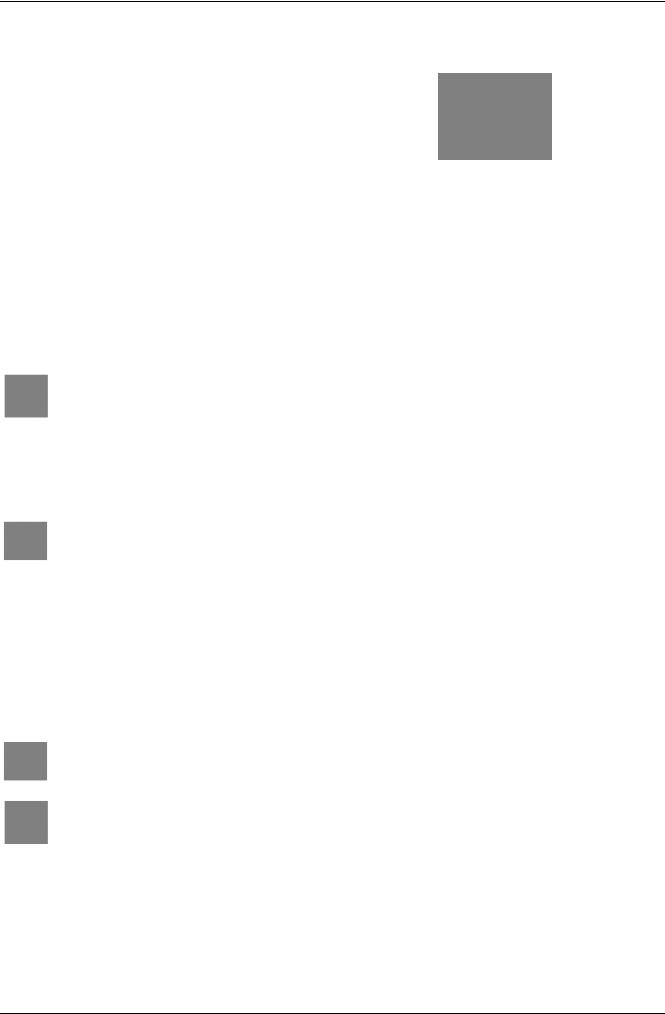
INSTRUCTIONS FOR USE 
Cylindrical brush application guide (suggestions only)
Models |
Polypropylene 0.40 |
Hard nylon 0.60 |
Soft nylon 0.45 |
General cleaning: |
|
|
|
|
|
|
|
Concrete |
|
|
|
Terrazzo floor |
|
|
|
Ceramic tiles/quarrystones |
|
|
|
Marble |
|
|
|
Vinyl tiles |
|
|
|
Rubber tiles |
|
|
|
|
|
|
|
Squeegee installation
1.Install the squeegee (25) and fasten it with the handwheels (26), then connect the vacuum hose (15) to the squeegee.
2.With the handwheel (27), adjust the squeegee so that the rear blade - in all its length - touches the floor and the front blade is slightly detached from the floor.
Guide to match squeegees and brush/pad-holder decks
Deck model |
Squeegee model |
Deck with one brush (18a), brush diameter: 20.9 in (530 mm) |
Aluminum (Fig. 6), width 29.9 in (760 mm) |
|
|
Deck with two brushes (18b), brush diameter: 12.0 in (305 mm) |
Steel (Fig. 5), width 31.9 in (810 mm) |
|
|
Deck with two cylindrical brushes (18c), brush length: 19.1 in (485 mm) |
Aluminum (Fig. 6), width 29.9 in (760 mm) |
|
|
Solution or washing water tank filling
NOTE
For X20D, X20C, X24D: [switch (77) (optional) enabled] pour clean water in the tank.
For 20D: pour solution.
1.Open the filler neck (8).
2.(For 20D)
Fill the tank (20) with a solution suitable for the work to be carried out. Do not fill the solution tank completely, leave few inches from the edge.
Always follow the dilution instructions on the label of the chemical product used to prepare the solution. The solution temperature must not exceed +104°F (+40°C).
CAUTION!
Use only low-foam and non-flammable detergents, intended for automatic scrubber applications.
(For X20D, X20C, X24D)
Fill the tank (20) with clean water.
Do not fill the clean water tank completely, leave a few inches from the edge. The water temperature must not exceed +104°F (+40°C).
Detergent tank filling (for X20D, X20C, X24D)
1.Open the cover (22) and check that the recovery water tank (21) is empty, otherwise empty it with the drain hose (16).
2.Grasp the handle (41) and carefully lift the tank (40).
3.Open the plug (46).
4.Fill the tank (45) with a detergent suitable for the work to be carried out (highly concentrated detergents). Do not fill the detergent tank completely, leave a few inches from the edge.
CAUTION!
Use only low-foam and non-flammable detergents, intended for automatic scrubber applications.
NOTE
If the detergent hose (48) is empty (in case of new system, system emptied for cleaning, etc.), in order to fill the hose quickly, it may be useful to drain the AXP once or several times (see the procedure in the Maintenance chapter).
9096910000(1)2006-09 |
17 |
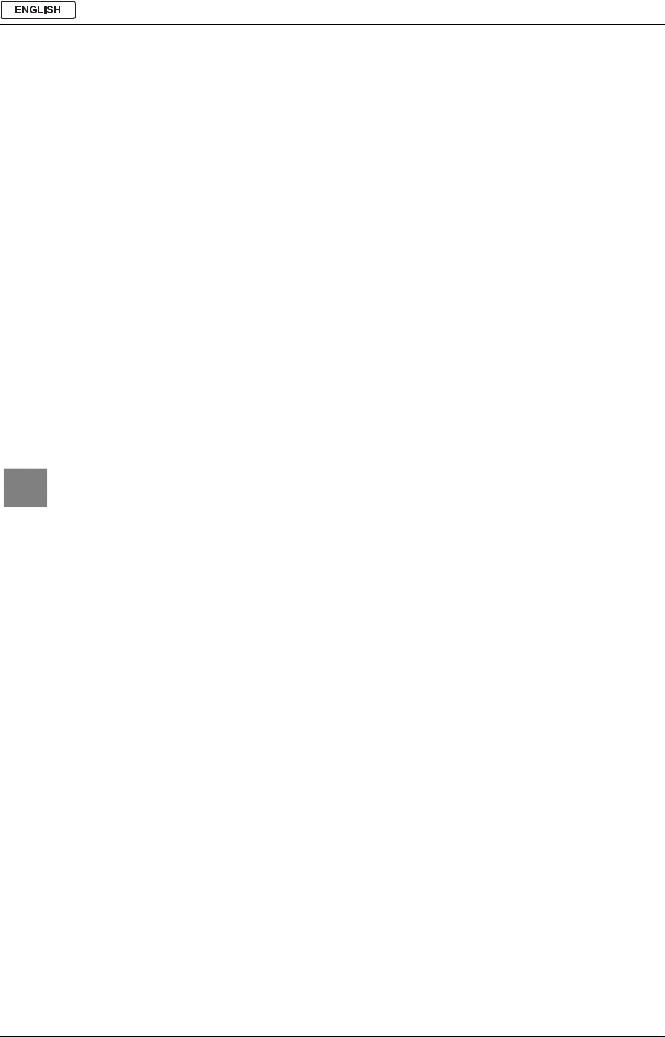
INSTRUCTIONS FOR USE
MACHINE START AND STOP
Starting the machine
1.Prepare the machine as shown in the previous paragraph.
2.Turn the ignition key (80) to “I” position.
Check that the green warning light (81a) turns on (charged batteries).
If the yellow or red warning light (81b or 81c) turns on, turn the ignition switch back to “0” position and charge the batteries (see the procedure in the Maintenance chapter).
3.Drive the machine to the working area, by keeping the hands on the handlebar (2) and pressing the paddle (83) forward to move forward, and backwards to move in reverse.
The maximum forward speed can be adjusted with the adjuster (84).
4.Lower the squeegee (25) with the lever (10).
5.Lower the brush/pad-holder deck by pressing the pedal (11).
6.Press the brush/pad-holder and vacuum system switch (71).
7.Press the washing water flow control switches (82) as necessary, depending on the type of cleaning to be carried out.
8.Start cleaning, by moving the machines as shown in step 3. If necessary, adjust the maximum speed with the adjuster (84).
Stopping the machine
9.Stop the machine by releasing the paddle (83).
10.Turn off the brushes/pad-holders and the vacuum system by pressing the switches (71) and (73).
11.Lift the brush/pad-holder deck by pressing the pedal (11).
12.Lift the squeegee (25) with the lever (10).
13.Make sure that the machine cannot move independently.
MACHINE OPERATION (SCRUBBING/DRYING)
1.Start the machine as shown in the previous paragraph.
2.If necessary, press the washing water flow control switches (82) as necessary, depending on the type of cleaning to be carried out.
3.If necessary, stop the machine and adjust the balancing handwheel (27) of the squeegee (25).
CAUTION!
To avoid any damage to the floor surface, turn off the brushes/pad-holders when the machine stops in one place, especially when the extra pressure function is on.
Detergent flow adjustment
(For X20D, X20C, X24D)
To check the actual setting of the detergent percentage to be added to the washing water, perform the following procedure:
1.Turn off the flow control switch (A, Fig. 4) [the warning light (B) must be off].
2.Press and hold the flow control switch (A). 3 seconds after pressing the switch, the indicator (C) turns on, thus indicating the percentage, as shown in the figure.
18 |
9096910000(1)2006-09 |
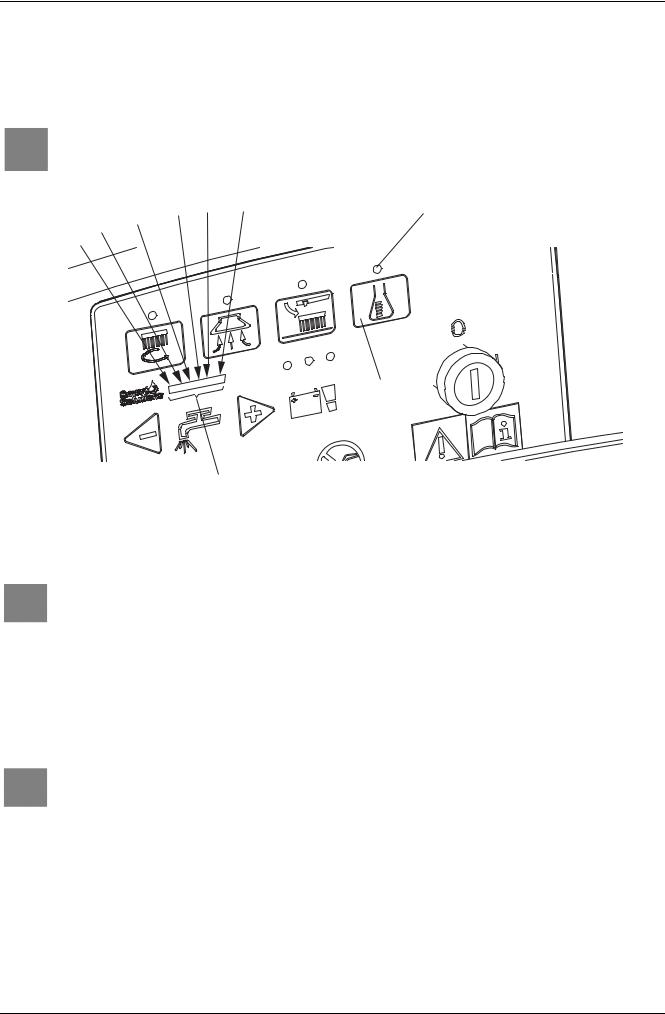
INSTRUCTIONS FOR USE 
To change the actual setting of the detergent percentage to be added to the washing water, perform the following procedure:
3.Turn off the flow control switch (A, Fig. 4) [the warning light (B) must be off].
4.Press and hold the flow control switch (A) until the warning light (B) flashes.
5.Release the switch (A). Press it again shortly, to go to the next percentage shown by the indicator (C); repeat the procedure until the desired setting is reached.
6.Wait for the warning light (B) to turn off and for the indicator (C) to show the washing water flow: the new percentage value is now set.
NOTE
Detergent percentage setting is stored into memory, even if the machine is turned off.
1% 2% 3% |
B |
0,4% 0,8%
0,25%
A
C
S311319
Figure 4
Working with brush/pad-holder extra pressure function turned on
7.If the floor proves to be particularly difficult to clean, it is possible to turn on the brush/pad-holder extra pressure function by pressing the pedal (11) to position (11c).
CAUTION!
When the cylindrical brush deck (18c) is installed, the extra pressure function is not enabled.
Battery discharge during operation
8.Until the green warning light (81a) stays on, the batteries allow the machine to work normally.
When the green warning light (81a) turns off, and the yellow warning light (81b) turns on, it is advisable to charge the batteries, because the residual autonomy will last for a few minutes (depending on battery characteristics and work to be performed).
When the red warning light (81c) turns on, the autonomy is over. After a few seconds, the brushes/pad-holders are automatically tuned off, while the vacuum system and the drive system stay on, to finish drying the floor and drive the machine to the appointed recharging area.
CAUTION!
Do not use the machine with discharged batteries, to avoid damaging the batteries and reducing the battery life.
9096910000(1)2006-09 |
19 |
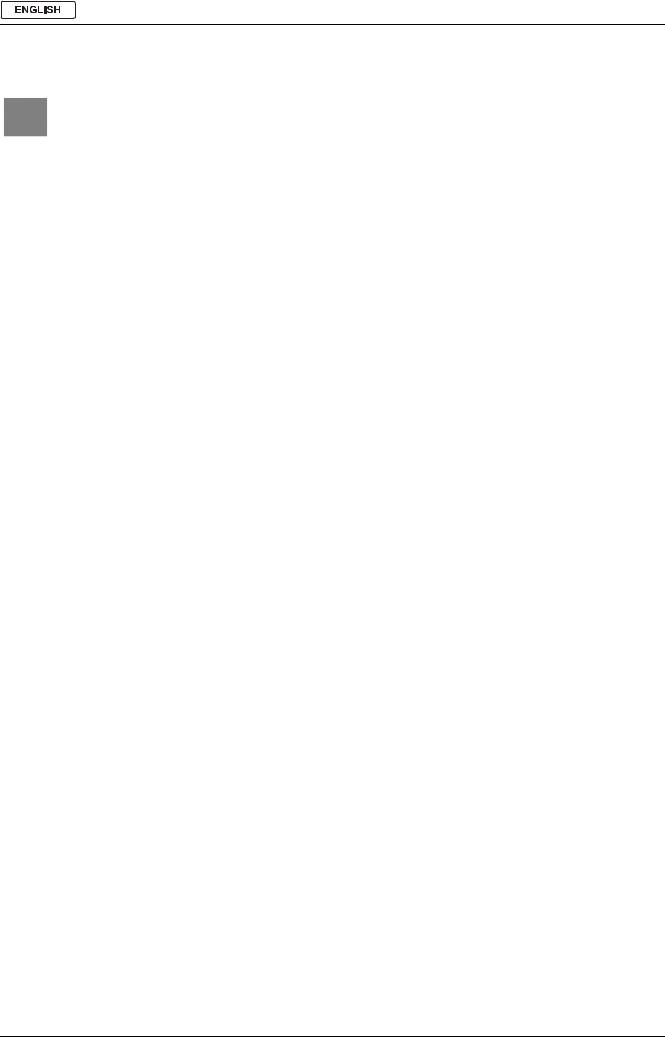
INSTRUCTIONS FOR USE
TANK EMPTYING
An automatic float shut-off system (36) stops the vacuum system when the recovery water tank (21) is full.
The vacuum system deactivation is signaled by a sudden increase in the vacuum system motor noise frequency.
CAUTION!
If the vacuum system turns off accidentally (for example, when the float is activated because of a sudden machine movement), to resume the operation: turn off the vacuum system by pressing the switch (73), then open the cover (22) and check that the float inside the grid (36) has gone down to the water level. Then close the cover (22) and turn on the vacuum system by pressing the switch (73).
When the recovery water tank (21) is full, empty it according to the following procedure.
Recovery water tank emptying
1.Stop the machine.
2.Lift the brush/pad-holder deck by pressing the pedal (11).
3.Lift the squeegee (25) with the lever (10).
4.Drive the machine to the appointed disposal area.
5.Empty the recovery water tank by means of the hose (16). After working, rinse the tank with clean water. Use the removable hose (9) (if equipped).
Solution/clean water tank emptying
6.Perform steps 1 to 4.
7.Empty the solution tank with the hose (17). After working, rinse the tank with clean water.
Cylindrical brush debris container emptying (only for cylindrical brush deck)
8.Stop the machine.
9.Lower the cylindrical brush deck and remove the debris container (D, Fig. 3) by pulling it on one side with the handle (E).
10.Empty and wash the debris container (D), and then install it by engaging it on the retainers.
AFTER USING THE MACHINE
After working, before leaving the machine:
1.Remove the brushes/pad-holders according to the procedure shown in the relevant paragraph.
2.Empty the tanks (20 and 21) and the debris container (D, Fig. 3) as shown in the relevant paragraph.
3.Perform the daily maintenance procedures (see the Maintenance chapter).
4.Store the machine in a clean and dry place, with the brushes/pad-holders and the squeegee lifted or removed.
MACHINE LONG INACTIVITY
If the machine is not going to be used for more than 30 days, proceed as follows:
1.Perform the procedures shown in After Machine Use paragraph.
2.Disconnect the battery connector (12).
FIRST PERIOD OF USE
After the first 8 hours, check the machine fastening and connecting parts for proper tightening and check the visible parts for integrity and leakage.
20 |
9096910000(1)2006-09 |

INSTRUCTIONS FOR USE 
MAINTENANCE
The lifespan of the machine and its maximum operating safety are ensured by correct and regular maintenance.
The following table provides the scheduled maintenance. The intervals shown may vary according to particular working conditions, which are to be defined by the person in charge of the maintenance.
WARNING!
The procedures must be carried out with the machine off and the battery disconnected. Moreover, read carefully the instructions in the Safety chapter before performing any maintenance procedure.
All scheduled or extraordinary maintenance procedures must be performed by qualified personnel, or by an authorized Service Center.
This Manual describes only the easiest and most common maintenance procedures.
For other maintenance procedures shown in the Scheduled Maintenance Table, refer to the Service Manual that can be consulted at any Service Center.
SCHEDULED MAINTENANCE TABLE
Procedure |
Daily, after |
Weekly |
Every six months |
Yearly |
|
machine use |
|||||
|
|
|
|
||
|
|
|
|
|
|
Battery charging |
|
|
|
|
|
Squeegee cleaning |
|
|
|
|
|
Brush/pad cleaning |
|
|
|
|
|
Tank and vacuum grid with float cleaning, and cover gasket |
|
|
|
|
|
check |
|
|
|
|
|
Squeegee blade check and replacement |
|
|
|
|
|
Solution/clean water filter cleaning |
|
|
|
|
|
Vacuum system motor cleaning |
|
|
|
|
|
WET battery fluid level check |
|
|
|
|
|
Screw and nut tightening check |
|
|
(1) |
|
|
|
|
|
|
|
|
Brush/pad-holder motor carbon brush check or replacement |
|
|
|
(2) |
|
Vacuum system motor carbon brush check or replacement |
|
|
|
(2) |
|
Drive system motor carbon brush check or replacement |
|
|
|
(2) |
|
|
|
|
|
|
(1): And after the first 8 working hours.
(2): This maintenance procedure must be performed by an authorized Nilfisk-Advance Service Center.
CHARGING THE BATTERIES
NOTE
Charge the batteries when the yellow or red warning light (81b or 81c) turns on, or at the end of every working cycle.
CAUTION!
Keeping the batteries charged make their life last longer.
CAUTION!
When the batteries are discharged, charge them as soon as possible, as that condition makes their life shorter. Check for battery charge at least once a week.
WARNING!
WET battery charging produces highly explosive hydrogen gas. Charge the batteries in well-ventilated areas and away from bare flames. Do not smoke while charging the batteries.
Keep the tank assembly open while charging the batteries.
WARNING!
Pay careful attention when charging the batteries as there may be battery fluid leakages. The battery fluid is corrosive. If it comes in contact with skin or eyes, rinse thoroughly with water and consult a physician.
9096910000(1)2006-09 |
21 |
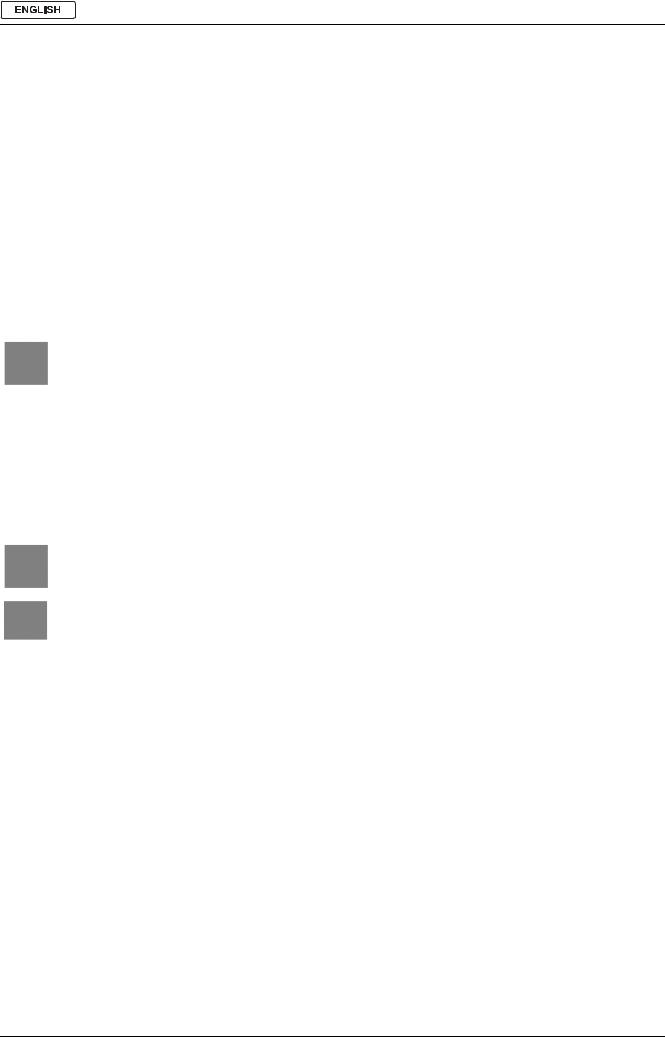
INSTRUCTIONS FOR USE
Preliminary procedures
1.Open the cover (22) and check that the recovery water tank (21) is empty, otherwise empty it with the drain hose (16).
2.Drive the machine to the appointed recharging area.
3.Turn the ignition key (80) to “0” position.
4.Grasp the handle (41) and carefully lift the tank (40).
5.For WET batteries only:
–Check the level of electrolyte inside the batteries (52); if necessary, top up through the caps (53).
–Then leave all the caps (53) open for battery charging.
–If necessary, clean the upper surface of the batteries.
6.Charge the batteries according to one of the following procedures, depending on the presence of the battery charger (90).
Battery charging
7.Connect the battery charger cable (6) to the electrical mains (the electrical mains voltage and frequency must be compatible with the battery charger values shown on the machine serial number plate (34)).
When the battery charger is connected to the electrical mains, all machine functions are automatically cut off.
If the red warning light (94) on the battery charger control panel stays on, the battery charger is charging the batteries.
8.When the green warning light (92) turns on, the battery charging is completed.
9.When the battery charging is completed, disconnect the battery charger cable (6) from the electrical mains and wind it round its housing (7).
10.Grasp the handle (41) and carefully lower the tank (40).
NOTE
For further information about the operation of the battery charger (90), see the relevant Manual.
MACHINE WORKING HOUR CHECK
(Only if the machine is equipped with hour counter)
1.Turn the ignition key (80) to “I” position.
2.Press the switch (73) and read on the hour counter (79) the total number of working hours (scrubbing/drying) performed by the machine.
3.Press the switch (73) again.
4.Turn the ignition key (80) to “0” position.
SQUEEGEE CLEANING
NOTE
The squeegee must be clean and its blades must be in good conditions in order to get a good drying.
CAUTION!
It is advisable to use protective gloves when cleaning the squeegee because there may be sharp debris.
1.Drive the machine on a level floor.
2.Turn the ignition key (80) to “0” position.
3.Lower the squeegee (25) with the lever (10).
4.Loosen the handwheels (26) and remove the squeegee (25).
5.Disconnect the vacuum hose (15) from the squeegee.
6.Clean the steel squeegee (Fig. 5) or the aluminum squeegee (Fig. 6). Clean the compartments (A, Fig. 5 or 6) and the hole (B) especially. Check the front blade (C) and the rear blade (D) for integrity, cuts and tears; otherwise replace them (see the procedure in the following paragraph).
7.Assemble the squeegee in the reverse order of disassembly.
22 |
9096910000(1)2006-09 |
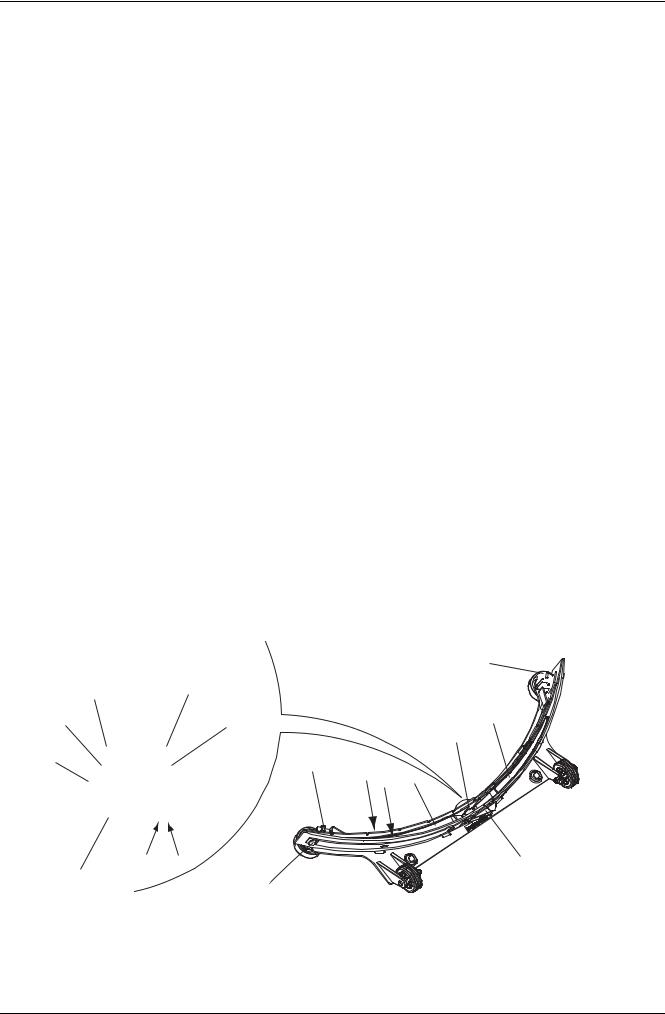
INSTRUCTIONS FOR USE 
SQUEEGEE BLADE CHECK AND REPLACEMENT
1.Clean the steel squeegee (Fig. 5) or the aluminum squeegee (Fig. 6), according to the procedure shown in the previous paragraph.
2.Check that the edges (E, Fig. 5 or 6) of the front blade (C) and the edges (F) of the rear blade (D) lay down on the same level, along their length; otherwise adjust their height according to the following procedure:
–Release the tie rod (G, Fig. 5 or 6) and loosen the wing nuts (H, Fig. 5), or disengage the retainers (M, Fig. 6) and adjust the rear blade (D, Fig. 5 or 6), then tighten the wing nuts or engage the retainers, and engage the tie rod.
–Loosen the handwheels (I) and adjust the front blade (C, Fig. 5 or 6), then tighten the handwheels.
3.Check the front blade (C, Fig. 5 or 6) and rear blade (D) for integrity, cuts and tears; otherwise replace them according to the following procedure. Check that the front corner (J) of the rear blade is not worn; otherwise, overturn the blade to replace the worn corner with an integral one. If the other corners are worn too, replace the blade according to the following procedure:
–Disengage the tie rod (G), remove the wing nuts (H) or disengage the retainers (M), remove the retaining strip (K) and replace/overturn the rear blade (D).
Assemble the blade in the reverse order of disassembly.
–Unscrew the handwheels (I) and remove the retaining strip (L), then replace the front blade (C). Assemble the blade in the reverse order of disassembly.
After the blade replacement (or overturning), adjust the height as shown in the previous step.
4.Connect the vacuum hose (15) to the squeegee.
5.Install the squeegee (25) and screw down the handwheels (26).
6.If necessary, adjust the squeegee balance adjusting handwheel (27).
S311320
Figure 5
I
C D 
 M
M
L K A B
I I
C D A
J F G
E M
S311326
Figure 6
9096910000(1)2006-09 |
23 |
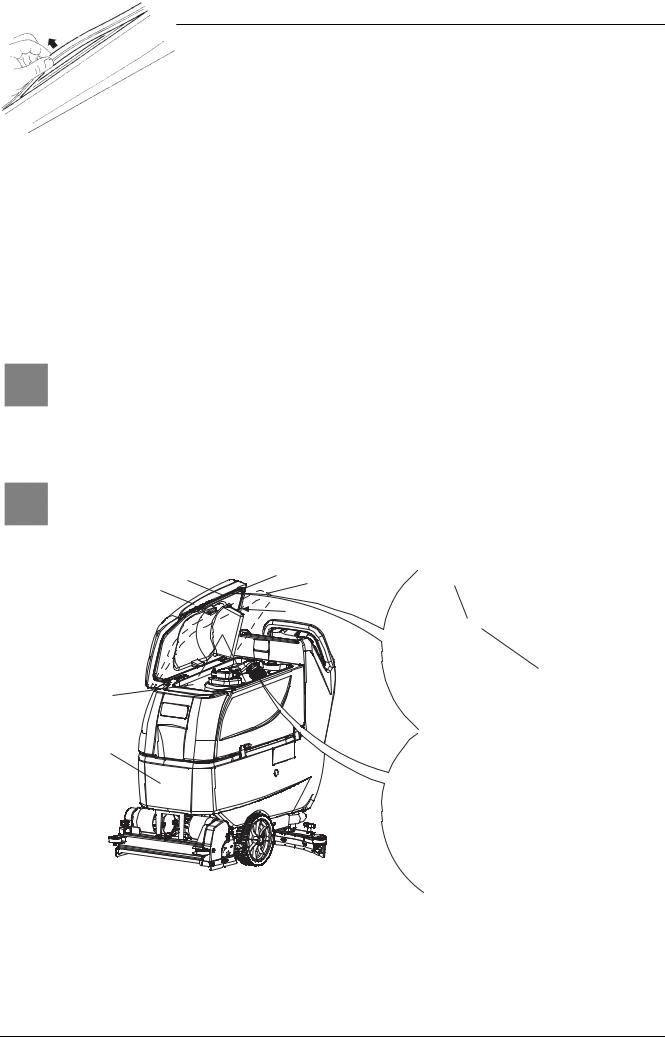
INSTRUCTIONS FOR USE
BRUSH/PAD CLEANING
CAUTION!
It is advisable to use protective gloves when cleaning the brushes/pads/cylindrical brushes because there can be sharp debris.
1.Remove the brushes/pads from the machine, as shown in the Use chapter.
2.Clean and wash the brushes/pads with water and detergent.
3.Check that the brushes/pads are integral and not excessively worn; otherwise replace them.
4.On the machines equipped with the cylindrical brush deck, remove the debris container (D, Fig. 3) by pulling it on one side with the handle (E).
Empty and wash the debris container (D), and then install it by engaging it on the retainers.
TANK AND VACUUM GRID WITH FLOAT CLEANING, AND COVER GASKET CHECK
1.Drive the machine to the appointed disposal area.
2.Turn the ignition key (80) to “0” position.
3.Open the cover (A, Fig. 7) to washing position (L).
4.Wash with clean water the cover (A), the tanks (B and C) and the vacuum grid with automatic shut-off float (D). Drain the water from the tanks with the hoses (16 and 17).
5.If necessary, release the retainers (E) and open the grid (D), recover the float (F), clean all the components and then reinstall them.
6.Check the tank cover gasket (G) for integrity.
NOTE
The gasket (G) creates vacuum in the tank that is necessary for vacuuming the recovery water.
If necessary replace the gasket (G) by removing it from its housing (H). When assembling the new gasket, install the joint
(I) in the rear central area, as shown in the figure.
7.Check that the bearing surface (J) of the gasket (G) is integral and adequate for the gasket itself.
8.Check the compensation hole (K) for clogging, and clean it if necessary.
NOTE
The hole (K), allowing to compensate the air in the cover interspaces, contributes to create vacuum in the tank.
9.Close the cover (A).
A G  K L G
K L G
I
J
B
C
F
S311321
Figure 7
24 |
9096910000(1)2006-09 |
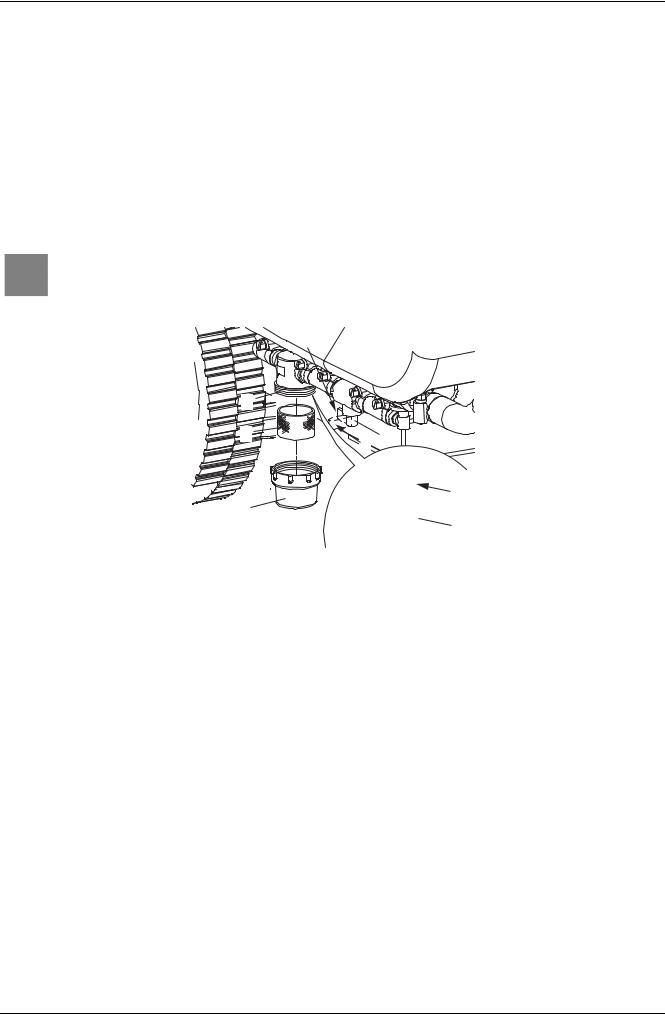
INSTRUCTIONS FOR USE 
VACUUM SYSTEM MOTOR FILTER CLEANING
1.Drive the machine on a level floor.
2.Turn the ignition key (80) to “0” position.
3.Open the recovery water tank.
4.If necessary, drain the water from the tank in order to make the filter visible.
5.Check that the pre-filter is clean. If necessary clean it with water and compressed air, then install it.
6.Carry out steps 1, 2 and 3 in the reverse order.
SOLUTION FILTER CLEANING
(For 20D)
1.Drive the machine on a level floor.
2.Turn the ignition key (80) to “0” position.
3.Close the solution tap (A, Fig. 8) under the machine, behind the right rear wheel. The tap (A) is closed when it is on the position (B) and it is open when it is on the position (C).
4.Remove the transparent cover (D), then remove the filter strainer (E). Clean and install them on the support (F).
NOTE
The filter strainer (E) must be correctly positioned on the housing (G) of the support (F).
5.Open the tap (A).
|
C |
|
F |
|
|
E |
B |
A |
|
||
D |
|
G |
|
E |
|
|
|
|
|
Figure 8 |
S311322 |
|
|
9096910000(1)2006-09 |
25 |
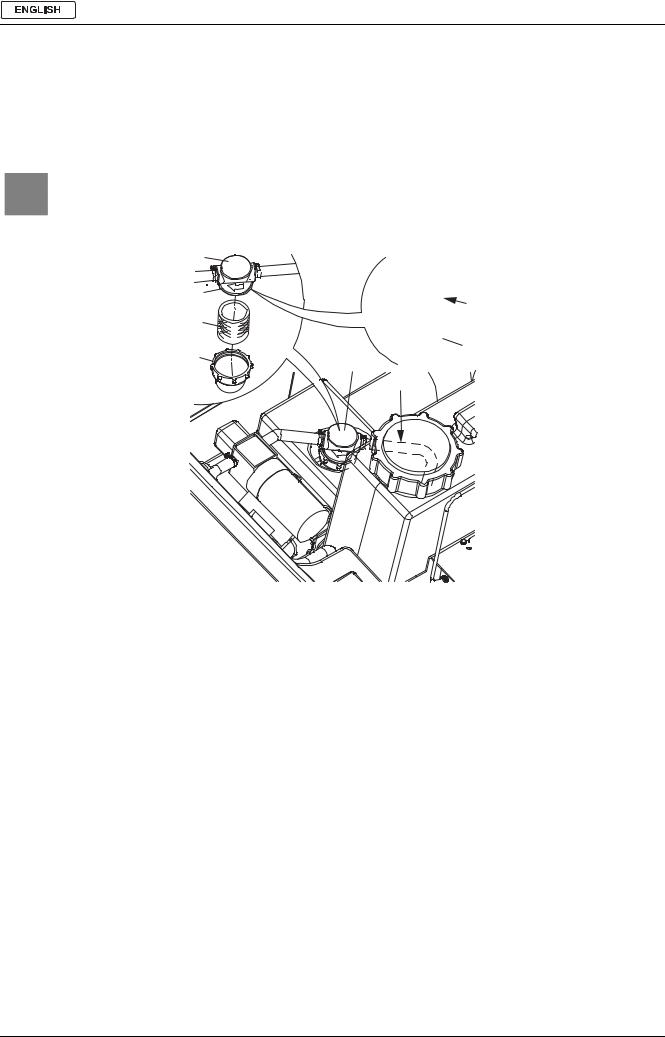
INSTRUCTIONS FOR USE
CLEAN WATER FILTER CLEANING
(For X20D, X20C, X24D)
1.Drive the machine on a level floor.
2.Turn the ignition key (80) to “0” position.
3.Open the cover (22) and check that the recovery water tank (21) is empty, otherwise empty it with the drain hose (16).
4.Grasp the handle (41) and carefully lift the tank (40).
5.Slightly lift the hoses (A, Fig. 9), then, operating on the clean water filter assembly (F) unscrew the transparent cover (B) and remove the filter strainer (C). Clean and install them on the support (D).
NOTE
The filter strainer (C) must be correctly positioned on the housing (E) of the support (D).
6.Lower the hoses (A) and the filter strainer (F).
F |
|
|
D |
E |
|
C |
||
|
||
B |
C |
|
F |
||
|
||
|
A |
S311323
Figure 9
26 |
9096910000(1)2006-09 |

INSTRUCTIONS FOR USE 
FUSE CHECK/REPLACEMENT
1.Disconnect the battery connector (12).
2.Move aside the recovery water drain hose (16).
3.Remove the battery charger cable (I, Fig. 10) from the holder (J).
4.Remove the screws (A) and carefully move aside the panel (B) by disengaging the grommet (K) from its housing on the panel (B).
5.Check/replace the following fuses: (C)F1 fuse, deck: (40 A)
(D)F2 fuse, vacuum system: (30 A) (E)F3 fuse, drive system: (30 A) (F)F4 fuse, signal circuits: (3 A)
(G)F5 fuse, brush/pad-holder release: (20 A) (H)F6 fuse, pump: (3 A)
6.Perform steps 1 to 4 in the reverse order.
A B A

 D
D
E
C
F G H A 





 A
A 







J
I K
S311324
Figure 10
9096910000(1)2006-09 |
27 |
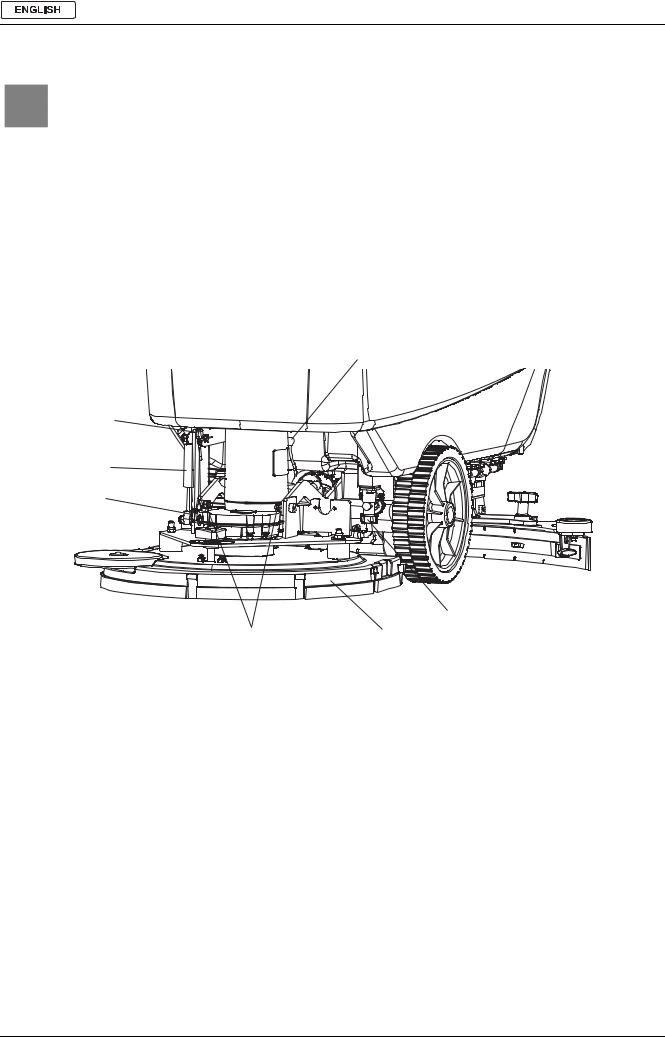
INSTRUCTIONS FOR USE
BRUSH/PAD-HOLDER/CYLINDRICAL BRUSH DECK DISASSEMBLY/ASSEMBLY
The machine can be equipped with either the brush/pad-holder deck (18a and 18b) or the cylindrical brush deck (18c).
NOTE
When the deck is installed/removed, it may be necessary to change the squeegee too, because they must have the same width. For correct matching of deck and squeegee, see the Squeegee Installation paragraph.
Disassembly
1.Drive the machine on a level floor.
2.Remove the brushes/pad-holders according to the procedure shown in the relevant paragraph. Do not remove the cylindrical brushes.
3.Lower the brush/pad-holder deck by pressing the pedal (11).
4.If equipped, remove the cotter pins (B, Fig. 11) and the gas spring (A).
5.Disconnect the brush/pad-holder motor electrical connection (D).
6.Disconnect the solution hose (E) from the solenoid valve (F).
7.Remove the screws (C), then remove the brush/pad-holder deck (F).
Assembly
8.Assemble the components in the reverse order of disassembly, and note the following:
– When the machine is equipped with the cylindrical brush deck (18c), the gas spring (A) must not be installed.
D
B
A
B
C |
E |
F |
|
|
S311325 |
|
Figure 11 |
28 |
9096910000(1)2006-09 |
